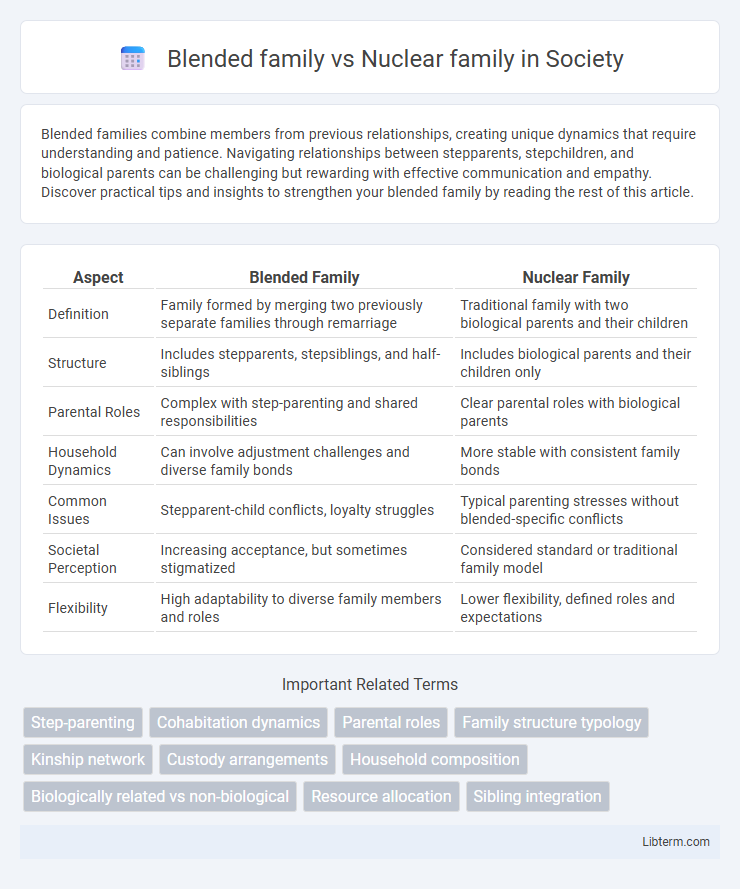Blended families combine members from previous relationships, creating unique dynamics that require understanding and patience. Navigating relationships between stepparents, stepchildren, and biological parents can be challenging but rewarding with effective communication and empathy. Discover practical tips and insights to strengthen your blended family by reading the rest of this article.
Table of Comparison
| Aspect | Blended Family | Nuclear Family |
|---|---|---|
| Definition | Family formed by merging two previously separate families through remarriage | Traditional family with two biological parents and their children |
| Structure | Includes stepparents, stepsiblings, and half-siblings | Includes biological parents and their children only |
| Parental Roles | Complex with step-parenting and shared responsibilities | Clear parental roles with biological parents |
| Household Dynamics | Can involve adjustment challenges and diverse family bonds | More stable with consistent family bonds |
| Common Issues | Stepparent-child conflicts, loyalty struggles | Typical parenting stresses without blended-specific conflicts |
| Societal Perception | Increasing acceptance, but sometimes stigmatized | Considered standard or traditional family model |
| Flexibility | High adaptability to diverse family members and roles | Lower flexibility, defined roles and expectations |
Introduction to Family Structures
Blended families consist of partners with children from previous relationships, creating a mixed family unit that often involves complex dynamics and shared parenting responsibilities. Nuclear families typically include two parents and their biological or adopted children living together as a single household, emphasizing traditional family roles. Understanding these family structures is crucial for analyzing social development, child outcomes, and evolving family roles in contemporary society.
Defining Blended Families
Blended families consist of two adults who have remarried or cohabited, bringing children from previous relationships into a new, unified household. Unlike nuclear families, which typically include two biological parents and their children, blended families require navigating complex relationships and roles among stepparents, stepsiblings, and biological parents. Understanding the dynamics of blended families is essential for addressing unique emotional, social, and legal challenges inherent in these modern family structures.
Characteristics of Nuclear Families
Nuclear families typically consist of two parents and their biological or adopted children living in a single household, emphasizing close-knit relationships and shared responsibilities. This family structure often features clear parental roles, consistent routines, and focused emotional support, fostering stability and cohesion. The limited household size allows for concentrated resources and direct communication between family members, enhancing overall family functioning.
Emotional Dynamics in Blended vs. Nuclear Families
Blended families often experience complex emotional dynamics due to integrating diverse parenting styles, loyalty conflicts, and adjusting to new family roles, which can create initial stress and require effective communication for cohesion. In contrast, nuclear families typically have more established emotional patterns and stability, as members generally share a common history and consistent routines, fostering predictable emotional responses. Understanding these differences is essential for addressing the unique challenges and fostering emotional well-being in blended family environments.
Parenting Styles and Challenges
Blended families often face unique parenting challenges due to integrating different parenting styles, requiring adaptability, communication, and cooperation to manage step-parent roles and sibling relationships effectively. Nuclear families typically maintain consistent parenting approaches, often rooted in shared routines and established family dynamics, making discipline and emotional support more predictable. Conflicts in blended families may arise from loyalty issues and differing disciplinary methods, whereas nuclear families usually navigate challenges within a more unified parental framework.
Child Development Outcomes
Children in blended families often experience complex emotional dynamics due to varying parental roles and step-sibling relationships, which can impact their social adjustment and academic performance differently than those in nuclear families. Nuclear family environments typically provide more stability and consistent parenting approaches, contributing to more predictable developmental outcomes and stronger emotional security in children. Research indicates that effective communication and positive co-parenting in blended families can mitigate developmental challenges and promote resilience comparable to those observed in nuclear family settings.
Social Support and Community Perception
Blended families often benefit from expanded social support networks due to connections with multiple parental backgrounds, enhancing emotional and practical assistance. Nuclear families typically receive well-established community support but may face limited external resources compared to blended family structures. Community perception varies, with nuclear families generally viewed as traditional and stable, while blended families are increasingly accepted yet sometimes face stereotypes affecting social integration.
Financial Considerations and Resource Allocation
Blended families often face complex financial considerations due to multiple income sources, child support obligations, and shared expenses among step-siblings, requiring careful budgeting and transparent communication to allocate resources effectively. Nuclear families typically experience more straightforward financial planning with a single household income and fewer dependents, allowing for easier management of expenses and savings goals. The dynamics of blended families necessitate customized financial strategies to ensure equitable resource distribution and long-term financial stability for all members.
Communication Patterns in Each Family Type
Blended families often navigate complex communication patterns characterized by negotiating roles and establishing trust among stepparents, biological parents, and children, requiring explicit and frequent dialogue to resolve conflicts. Nuclear families typically exhibit more straightforward communication flows centered around parental guidance and sibling interaction, fostering stability through shared history and consistent routines. Effective communication in blended families emphasizes empathy and adaptability, while in nuclear families, it relies more on established familial norms and emotional closeness.
Choosing the Right Family Structure for Well-being
Choosing the right family structure for well-being depends on emotional support, stability, and adaptability. Blended families offer diverse relationships and resilience through shared experiences, while nuclear families provide consistency and clear boundaries. Prioritizing communication and mutual respect enhances well-being regardless of family type.
Blended family Infographic

 libterm.com
libterm.com